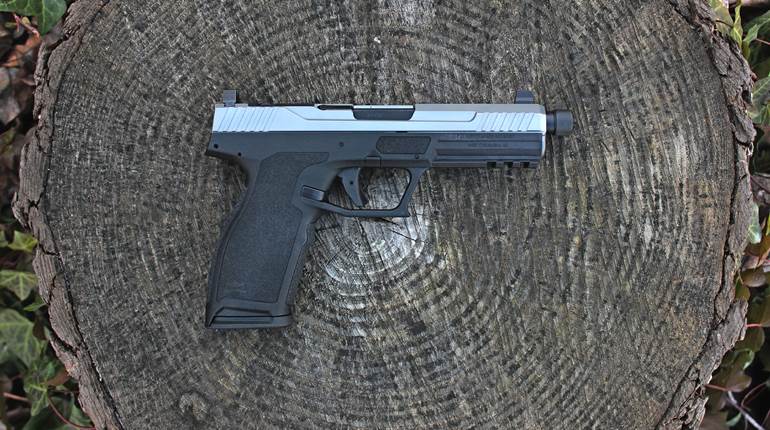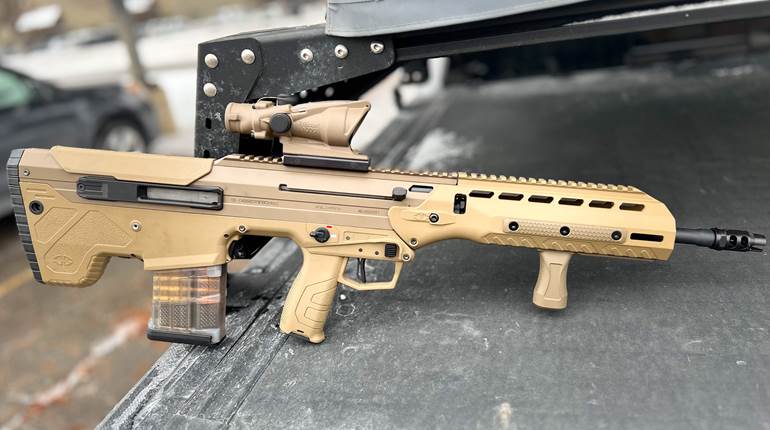
It was just a few years ago that Richard Dyke, the founder of Bushmaster Firearms International, re-opened the Windham, Maine firearms manufacturing facility that was closed when Bushmaster production was moved out of state. With many of the previous staff members returning to join the venture, the plant began operations again under the name of Windham Weaponry. This team of seasoned professionals has been busily building AR-style rifles to meet the high customer demand. In doing so, they've managed to keep up the pace without compromising their commitment to quality. For 2014, the company has decided to try something new by releasing what can best be described as a reduced-weight hybrid AR chambered for .308 Win./7.62 NATO cartridges, called the SRC-308.
The SRC-308 is a gas-impingement semi-auto rifle that weighs just 7.55 pounds, unloaded. Reducing the overall weight of the rifle was accomplished in three ways. First, the rifle is fitted with a carbine-length medium-profile barrel. This is where the largest amount weight was removed. Secondly, the upper and lower receivers have been trimmed down. Finally, wherever possible, standard AR-15 components have been used to keep the rifle slimmed down. This also allows for the installation of a variety of aftermarket parts, such as drop-in AR-15 competition trigger groups.
The 16.5-inch chrome-lined barrel is threaded and fitted with an A2-style flash hider. The gas block has a bayonet lug and is topped with a 1.75-inch Picatinny rail for removable front sights. It has been drilled to accept a quick detach (QD) shoulder sling mount and arrives with one installed. The rifle has the familiar ribbed, tapered handguard in place to protect the support hand from barrel burn.
Both the upper and lower receivers are constructed of forged 7075 T6 aircraft-grade aluminum. They have a unique configuration that cannot be directly compared to any other design currently on the market. The upper features a full-length Picatinny rail, which is the same height as the gas block, for mounting optics and irons sights. The charging handle has the external profile of an AR-15, although the internal dimensions have been altered a bit to accommodate the .308 cartridge. The lower receiver has left and right QD ports, located near the buffer tube, and an integral trigger guard. The dimensions of the lower look much like those of an AR-15, with the exception of the enlarged magazine well.
The rifle's controls should look and feel familiar to fans of the AR-15. On the right side of the upper receiver is a spring-loaded dust cover and a forward assist button. On the left is the standard bolt catch and safety lever. The smooth-faced steel bow trigger is attached to a factory-standard trigger group. This rifle's trigger had a typical factory feel but a fairly heavy trigger pull of 7 pounds, 3 ounces.
Instead of a standard hard-plastic A2 pistol grip, a much more comfortable Hogue over-molded grip with a pebbled soft rubber texture has been installed. Some aftermarket grips will interfere with the milled-in QD ports, so Windham went ahead and installed an upgraded grip they knew to be compatible. The six-position telescoping buttstock is a basic black polymer model with molded texturing on the buttplate and a fixed sling mount. The rifle ships with a single 20-round Magpul PMAG, a hard side carry case and a QD sling. Just add sights and ammunition and the rifle is ready to go. This particular version of the SRC-308 has a matte-black finish from stem to stern. But considering Windham's fondness for providing its customers with camouflage finishes, it probably won't be long before .308s of another color become available.
At the shooting range, the gas-impingement system of the SRC-308 ran reliably with the test ammunition fired, which included a mix of factory fresh .308 Win. hunting cartridges in bullet weights ranging from 150 to 175 grains. There were no malfunctions in the course of testing. All of the controls looked and felt snug and properly fit. They, along with the provided magazine, operated smoothly and properly without any problems. During off-the-bench firing, this rifle proved to have good balance and was comfortable to hold and aim. It's certainly light enough for all-day carry in the field. However, the rifle’s 7.5-pound weight and hard buttplate did not do much to reduce felt recoil, which came as no surprise.
The SRC-308 arrives without a sight system, and so the rifle was fitted with a Nikon M-308 BDC 800 4-16x42 riflescope, which has a reticle designed specifically for .308 rifles. The one-piece mount provided with the scope has a built-in 20 minute-of-angle (MOA) slope. As a long-range optic, it provided a bright, clear picture of the test targets that were only 100 yards away. This may be more scope than is needed for a carbine-length rifle, but I have yet to regret having "too much" of an optic to work with.
This rifle test provided an excellent opportunity to try out the MagnetoSpeed ballistic chronograph system. Most modern chronographs measure bullet speed using a pair of light sensors. Supported by a frame placed on a table top or tripod, the chronograph is set down range of the rifle about 15 feet or so and bullets are fired over it. As the bullet passes over the two sensors, the speed is measured and recorded. Unfortunately, these light sensor chronograph systems tend to be fussy and hard to work with. There are usually a bunch of components and cables to organize and assemble. If the light is not just right, sunlight shines directly into the sensor, the sensors are too close to the gun’s muzzle or the bullet does not pass through the 2x2-inch "sweet spot" of the sensors, then the shooter will get an error message. If the weather is windy, too cloudy or there is a little rain falling, then the chronograph has to be put away.
The Magnetospeed proved to be a good deal easier to work with. Instead of light sensors, this system uses a pair of magnetic sensors to check the speed of the bullet. The sensors are mounted into a short polymer armature that looks very much like a bayonet when attached via a strap to the rifle’s barrel. The "Bayo" sensor rests below the barrel just a few inches from the muzzle and is connected by a single electrical cable to a handy little screened chronograph that's about the size of a box of ammo. The entire system fits into a pistol-sized hard case and a computer-compatible SD memory card with adapter are provided for information storage.
Having configured the sensor to fit the SRC-308 before leaving for the range, it took less time to set up the MagnetoSpeed than it did to hang the first set of targets. All of the components can be handled right at the shooting bench with no need to travel down range. Having no sensitivity to light or muzzle blast, the system did not produce a single error message in the course of testing even though it was a cloudy, blustery, noisy spring day at the local outdoor range.
It should be noted that the velocities recorded by the MagnetoSpeed system are usually a little faster than those listed by the manufacturer or shown by other chronographs. This is because the bullet velocity is literally measured at the muzzle, not 5 yards away from the muzzle. The MagnetoSpeed V2 costs more (about double) than many of the light sensor systems currently available. However, the system is complete (no extra light, stands, screens, etc. are required), it’s reliable and much easier to work with. I'm impressed with the system and plan to put it to use in the future.
Formal accuracy testing for the SRC-308 was conducted from a benchrest, with the scope in place, by firing five-shot groups into targets set at 100 yards. I've heard from the manufacturer that they've been able to squeeze laboratory shot groups down to around 0.75 inches using a particular 168-grain boattail load with a custom competition trigger installed in the rifle. My groups with the factory 7-pound, 3-ounce trigger on a windy spring morning were not that tight. The five-shot groups ranged from 1.19 inches to 1.74 inches, with the best single group produced by Black Hills Ammunition 175-grain Match boat-tail hollow points [BTHP]. The Black Hills load yielded the best five group average of 1.34 inches, followed by ASYM Precision 168-grain Barnes TTSX loads at 1.54-inches, followed by Federal Premium Sierra Matchking 168-grain BTHP rounds at 1.57 inches.
So far, I've been pleased by the products from Windham Weaponry that I've had a chance to work with. The fit and finish of the rifles is excellent and they run just like they should. In a market flooded with AR-15s chambered for .223/5.56, the SRC-308 is certainly an interesting change of pace. The rifle is light, handy and is chambered in one of the most popular and flexible cartridges for the AR-pattern platform. Windham’s choice to build the rifle using AR-15 components where possible will make this unique rifle even more attractive to those shooters looking to dress it up with after-market parts.
Manufacturer: Windham Weaponry: Windhamweaponry.com
Model: R16FTT-308 “SRC-308”
Action: Semi-Automatic, Gas Impingement System
Caliber: .308 Winchester/7.62 NATO
Receiver: Flat Top Upper Receiver
Receiver Material: Forged 7075 T6 Aircraft Aluminum
Receiver Finish: Hardcoat Black Anodized
Bolt Material: Carpenter 158 Steel
Barrel: Medium Profile, Chrome Lined with A2 Flash Suppressor
Barrel Material: 4150M Chrome Moly Vanadium 11595E Steel
Safety: Manual Lever
Stock: Six-Position Telescoping Butt Stock
Fore-end: Mid Length Tapered Shielded Hand Guard
Pistol Grip: Hogue Over Molded Grip
Optic Mounts: Picatinny Rail on Upper Receiver and Gas Block
Sights: None
Barrel Length: 16.5”
Overall Length: 38” (34.19” with Stock Collapsed)
Weight: 7.55 lbs. without Magazine
Capacity: 20 + 1 Rounds
Twist: 1:10” RH
Rifle Grooves: 6
Accessories: One 20-Round Magpul PMag Magazine, Hard Case, QD Sling, Lock, Owner's Manual
Suggested Retail Price: $1,413







































